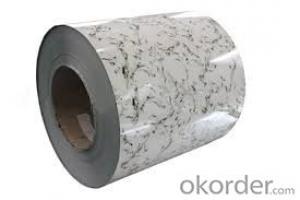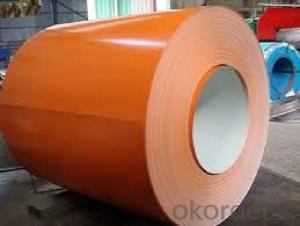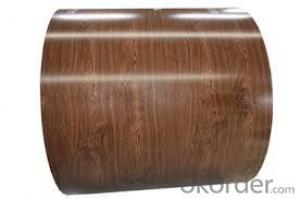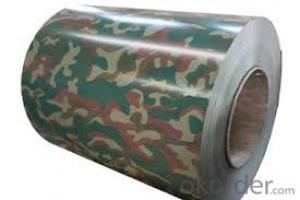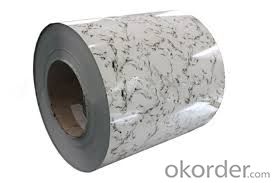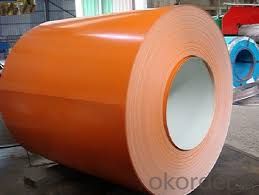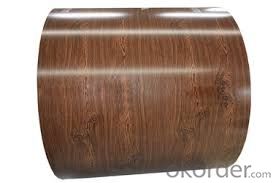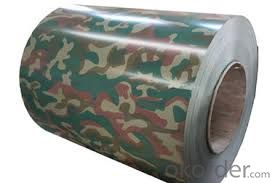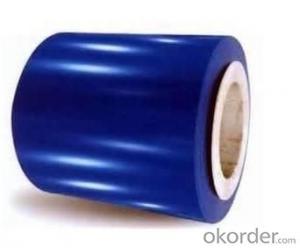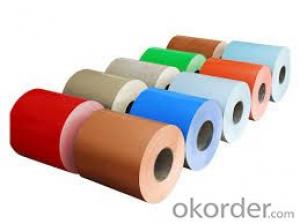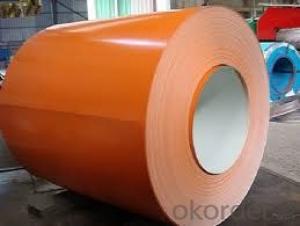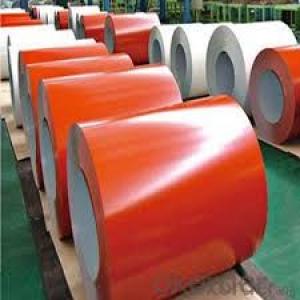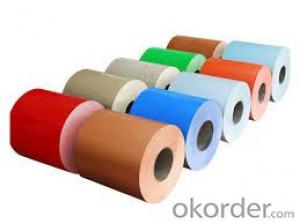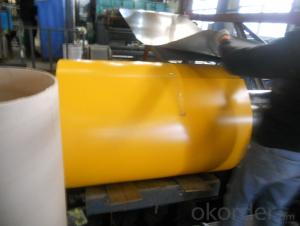Galvanized Surface Treatment Prepainted Galvanized Steel Coil
- Loading Port:
- Shanghai
- Payment Terms:
- TT OR LC
- Min Order Qty:
- 30 m.t.
- Supply Capability:
- 1000000 m.t./month
OKorder Service Pledge
OKorder Financial Service
You Might Also Like
Quick Details
| Standard: | ASTM,BS,DIN,GB,JIS | Grade: | TDX51D+Z | Thickness: | 0.3-0.7mm |
| Place of Origin: | Jiangsu China (Mainland) | Brand Name: | Huaxi | Model Number: | TDX51D+Z |
| Type: | Steel Coil | Technique: | Cold Rolled | Surface Treatment: | Coated |
| Application: | Construction Applied | Width: | 914-1250mm | Length: | Steel Coil |
| Approved Certificate: | CE & SGS | HS Code: | 72107000 | Available Coating Colors: | Off White & Sea Blue & Others |
| Inner Diameter: | 508-610mm | Available Dipped Layers: | 50-150G/M2 | Base Metal: | DX51D+Z |
| Description: | Prepainted Galvanized Steel Coil |
Packaging & Delivery
| Packaging Detail: | Standard seaworthy packing for international delivery |
| Delivery Detail: | According to the exact quantity of your order |
Cold Rolled Technique and Galvanized Surface Treatment Prepainted Galvanized Steel Coil
Brief Introduction
1. Prepainted Galvanized Steel Coil is coated with organic layer, which provides higher anti-corrosion property and a longer lifespan than that of galvanized steel sheets.
2. The base metal for Prepainted Galvanized Steel Coil is HDGI Steel. The finish coats of Prepainted Galvanized Steel Coil can be classified into groups as follows: polyester, silicon modified polyesters, polyvinylidene fluoride, high-durability polyester, etc.
3. The production process has evolved from one-coating-and-one-baking to double-coating-and-double-baking, and even three-coating-and-three-baking.
4. The color of the Prepainted Galvanized Steel Coil has a very wide selection, like orange, cream-colored, dark sky blue, sea blue, bright red, brick red, ivory white, porcelain blue, etc.
5. The Prepainted Galvanized Steel Coil can also be classified into groups by their surface textures, namely regular prepainted sheets, embossed sheets and printed sheets.
- Q: How are steel coils tested for mechanical properties?
- Steel coils are tested for mechanical properties through various methods, including tensile testing, hardness testing, and impact testing. Tensile testing involves stretching the steel coil until it breaks to determine its strength, elasticity, and ductility. Hardness testing measures the resistance of the steel to indentation or scratching, indicating its overall toughness. Impact testing involves striking the coil with a pendulum to assess its ability to absorb energy without fracturing. These tests help evaluate the quality and performance of steel coils in different applications.
- Q: Can cold rolled galvanized steel coils be acid washed after oxidation?
- Rolling at room temperature is generally understood as cold rolling, from a metallurgical point of view, below the rolling temperature at which the roll is rolled
- Q: What are the different coil cutting methods used for steel coils?
- There are several different coil cutting methods used for steel coils, including slitting, shearing, and laser cutting. Slitting involves using circular blades to cut the coil into narrower strips. Shearing involves using straight blades to cut the coil into desired lengths or shapes. Laser cutting, on the other hand, uses a high-powered laser beam to precisely cut the steel coil into specific shapes or patterns. Each method offers its own advantages and is chosen based on the desired outcome and requirements of the steel coil cutting process.
- Q: How are steel coils used in the production of building systems?
- Steel coils are used in the production of building systems as they provide a cost-effective and versatile material for various construction applications. These coils are often processed and shaped into different components, such as beams, columns, and roofing materials, to meet the structural requirements of buildings. The strength and durability of steel make it an ideal choice for constructing high-rise buildings, industrial facilities, and other structures that require stability and longevity.
- Q: How are steel coils made?
- Steel coils are made through a process called hot rolling, where steel slabs are heated and passed through a series of rollers to reduce their thickness and increase their length. These coils are then cooled and coiled into large rolls, ready for use in various industries such as automotive, construction, and manufacturing.
- Q: Can you suggest me names of sites which aids in construction of Pre Fabricated Steel Buildings.
- I okorder /... NCI produces many brand name buildings. Kirby Pasco If you get technical with your question I probably can help you. I have sold many millions of dollars worth of them. Depending on the manufacturer the directions are usually easy to follow. The only suggestion I have is avoid the brokers. Try and deal directly with the manufacturer. The construction plans are usually specific to your building not generic plans like some brokers have.
- Q: Does anyone know what colour steel is?How hard steel is?The density of steel?Conductivity of steel? (Heat and electricity)Reactivity of steel?Melting and boiling points of steel?And the malleability and ductility of steel?Ive looked all over the net and i cant find anything. Can someone please answer these questions or give me a website?THANKS!
- Steel is an alloy composed mainly of iron and carbon, but almost always contain small and various amounts of other elements. So all of these questions will have a range of answers. For example, the density of steel is between 0.280 and 0.291 pounds/cubic inch. The melting point for mild steel is around 2400F (1300C), but can be much higher, as in stainless steel which is 2800F because it contains a minimum of 11% chromium. Wiki has a legitimate definition.
- Q: I mean about if I had a piece of metal, how can i decide that's iron or steel?Sorry for bad English.
- Iron is a chemical element with the symbol Fe, that has no engineering application as it is very soft. You are not likely to come across a piece of metal of pure Iron. Steel is an alloy of Iron that is widely used with different types for various application. The type depends on the alloying elements. An old and rough way of identifying them is to use a chart, that shows the spark pattern when they are subjected to grinding.
- Q: What are the common maintenance practices for steel coils?
- Common maintenance practices for steel coils include regular cleaning to remove dirt, debris, and moisture, applying protective coatings to prevent corrosion, proper storage to avoid damage and contamination, and periodic inspections for any signs of damage or wear. Additionally, proper handling and transportation practices should be followed to prevent bending or crushing of the coils.
- Q: How are steel coils used in the agricultural sector?
- Various purposes in the agricultural sector call for the widespread use of steel coils. One primary utilization is seen in the construction of farm machinery and equipment. Tractors, plows, harvesters, and other heavy-duty machinery are frequently manufactured using steel coils. The exceptional strength and durability of steel make it an ideal material for such applications, as it can endure the challenging conditions of agricultural work. Furthermore, agricultural buildings and structures heavily rely on steel coils in their construction. Steel is renowned for its superior structural integrity, making it a popular choice for barns, storage units, and other agricultural facilities. Steel coils are frequently employed to establish the framework and support systems of these structures, providing stability and long-lasting durability. Moreover, irrigation systems also rely on steel coils in their production. Steel coils are often used to create the pipes and tubes used for water transportation in agricultural irrigation systems. Steel's resistance to corrosion and its ability to handle high-pressure flows make it an excellent choice for this particular application. To summarize, steel coils hold a critical role in the agricultural sector. Whether it be the construction of farm machinery and buildings or the development of irrigation systems, steel's strength and durability make it the preferred material in this industry.
Send your message to us
Galvanized Surface Treatment Prepainted Galvanized Steel Coil
- Loading Port:
- Shanghai
- Payment Terms:
- TT OR LC
- Min Order Qty:
- 30 m.t.
- Supply Capability:
- 1000000 m.t./month
OKorder Service Pledge
OKorder Financial Service
Similar products
Hot products
Hot Searches
Related keywords
